Google Nexus 4 Review - Google's new Flagship
by Brian Klug on November 13, 2012 8:45 AM EST- Posted in
- Smartphones
- LG
- Android
- Mobile
- APQ8064
- Nexus 4
- Android 4.2
- MDM9215
Battery life in the Nexus 4 is a big concern for many, especially since the Nexus 4 isn’t designed to have a user replaceable battery. What’s inside is a 2100 mAh 3.8V battery which is 8.0 watt-hours. I had been wondering for a while what the chemical compound used in the 3.8V battery cells we’re seeing emerge was, and finally got a tad more info at least about the LG Chem approach. This is the higher voltage chemistry from LG Chem which is Lithium Cobalt Oxide (LiCoO2) based and includes electrolyte additives to prevent gas generation in the cell which affects lifetime during high temperature periods. Although getting the back off of the Nexus 4 is relatively easy and requires just removing two Torx 4 screws and prying up on the plastic, I doubt anyone is going to make a back to accommodate an extended battery due to the presence of 4 antennas which are integrated into the back cover.
The Nexus 4 incorporates wireless charging into that back alongside NFC. For wireless charging the Nexus 4 uses a TI BQ51051b wireless power Li-Ion charger receiver. I’ve been pretty remiss in looking into wireless charging and actually trying it myself, so I went ahead and bought a two-position Energizer Qi compliant charging mat.
The Nexus 4 is Qi 1.1 wireless charging forum compliant, so any charger that is Qi compliant or includes the logo will charge it. Aligning the Nexus 4 on the Energizer mat is a bit tricky since the surface is slick and angled down, and the back of the Nexus 4 is primarily glass, but it isn’t difficult after you know where to align. The Nexus 4 charges from fully discharged to completely charged in 3.033 hours on the Qi mat, which is basically the same charge time as I saw off of microUSB on a BC 1.2 charger.
In Android you’ll see Charging (Wireless) when this mode is employed. I used the Palm Pre touchstone charger a lot back in the day and saw that get pretty hot during a charge cycle. The Nexus 4 doesn’t get nearly as warm. I’ve noticed that at the top of the charge cycle you’ll see the Nexus 4 selectively draw power from the charging dock since there doesn’t seem to be an equivalent trickle charge mode or something, but this is normal.
Battery Life
I’ve had the chance to run more battery life tests on the Nexus 4, and run the cellular test a few more times. The results are quite consistent and we don’t see that result change very much at all. I’ve also added the call time test and tethering results.
We regularly load web pages at a fixed interval until the battery dies (all displays are calibrated to 200 nits as always). The differences between this test and our previous ones boil down to the amount of network activity and CPU load.
On the network side, we’ve done a lot more to prevent aggressive browser caching of our web pages. Some caching is important otherwise you end up with a baseband test, but it’s clear what we had previously wasn’t working. I’ve made sure that despite the increased network load, the baseband still has the opportunity to enter its idle state during the course of the benchmark, we’re not destroying the RRC states with too aggressive of a load time.
We also increased CPU workload along two vectors: we decreased pause time between web page loads and we shifted to full desktop web pages, some of which are very JS heavy. The end result is a CPU usage profile that mimics constant, heavy usage beyond just web browsing. Everything you do on your smartphone ends up causing CPU usage peaks - opening applications, navigating around the OS and of course using apps themselves. Our 5th generation web browsing battery life test should map well to more types of smartphone usage, not just idle content consumption of data from web pages.
As always we test across multiple air interfaces (3G, 4G LTE, WiFi), but due to the increased network load we actually find that on a given process technology we see an increase in battery life on faster network connections. The why is quite simple to understand: the faster a page is able to fully render, the quicker all components can drive down to their idle power states. All Android tests use Chrome and 5GHz WiFi unless otherwise listed.
The tethering test still consists of four tabs of the webpage tests in conjunction with a 128 kbps streaming MP3 radio station over the smartphone’s personal WiFi hotspot.
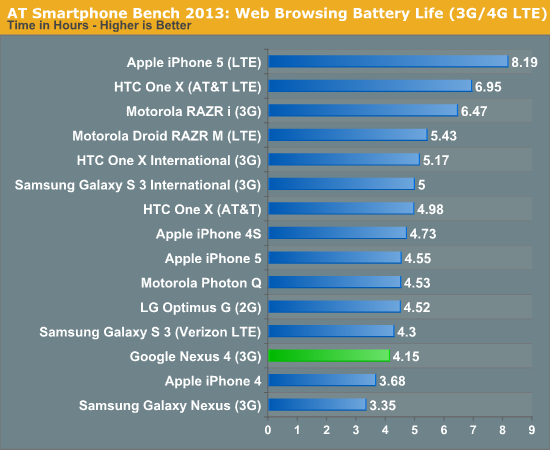
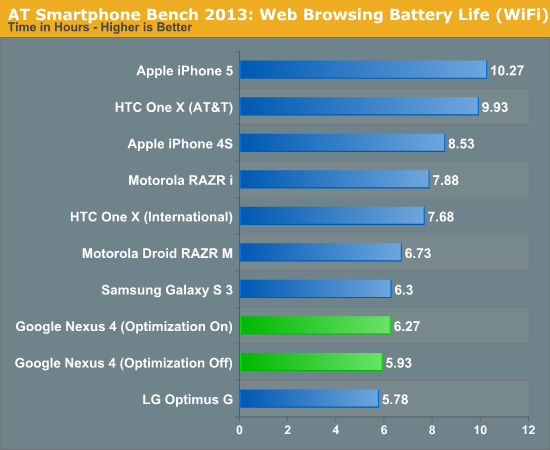
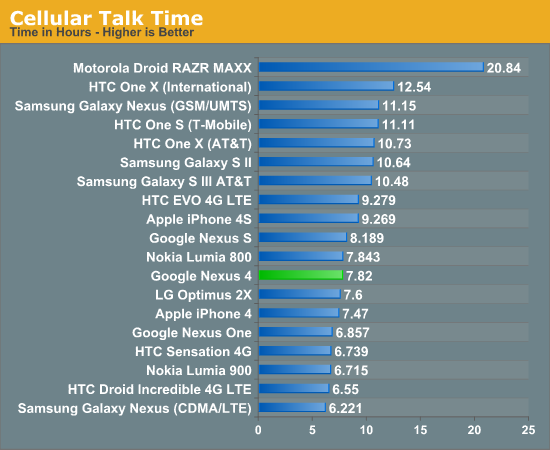
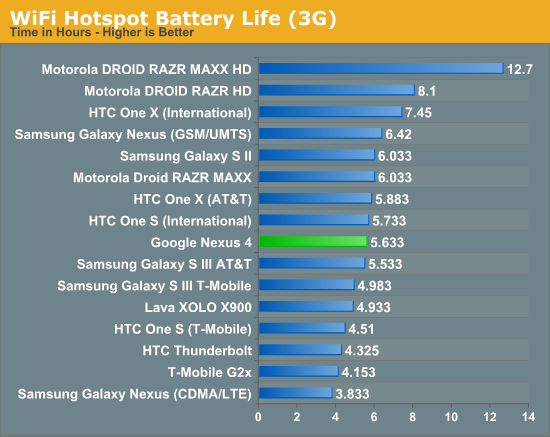
I've run and re-run the battery life tests on the Nexus 4 and they haven't changed since our preview a whole bunch. The result is battery life that isn't really chart topping, yet in my time with the Nexus 4 I haven't really been want for more battery life at any point. I'm able to get through a single day with the device set on auto brightness.



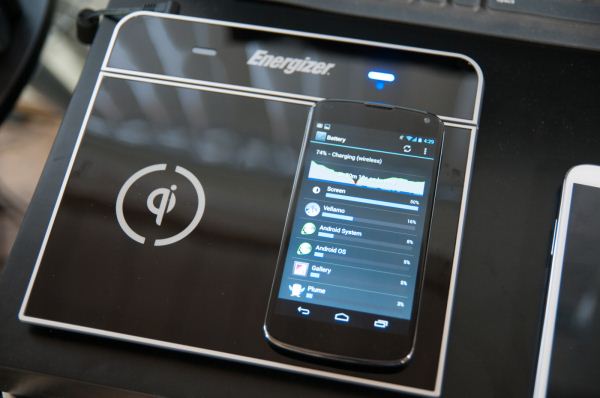

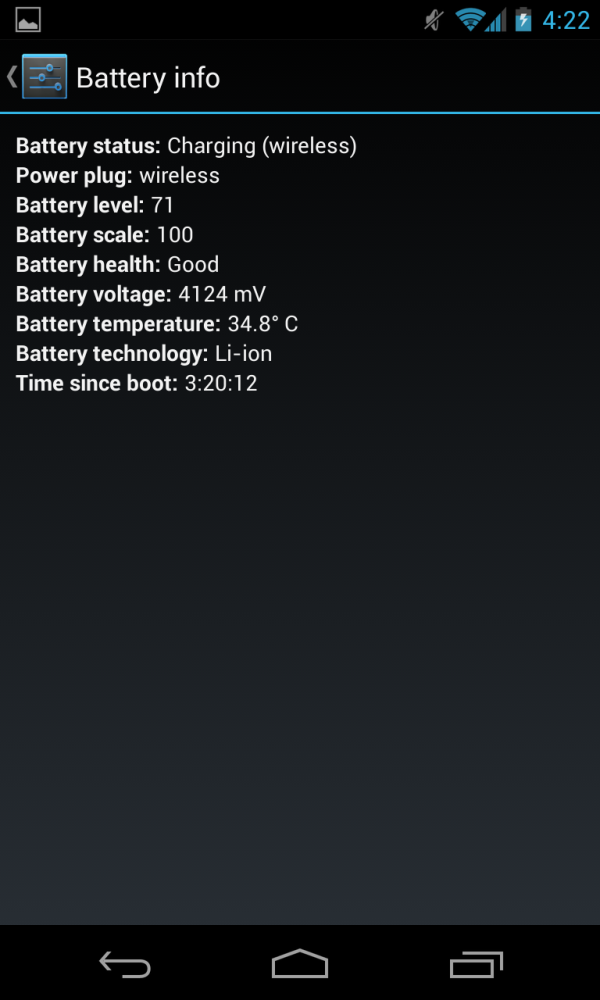








188 Comments
View All Comments
Freedomuser - Wednesday, November 14, 2012 - link
Not so fast. If the tests suite was intense like i think it's then even iphone 5 will get overheated.So, the question is, does any other phones in your chart survived the tests suite? LG Optimus G dropped out. Nexus 4 made it through with overheat. What about others on your chart?
meloz - Thursday, November 15, 2012 - link
>>Not so fast. If the tests suite was intense like i think it's then even iphone 5 will get overheated.But in this test it did not. And in any benchmark in which iphone5 will overheat, the Nexus 4 will overheat and throttl even worse!
I want Android and Nexus to do well, because they represent a more user-friendly (freedom) choice to iphone. But Google seriously need to address overheating, battery life and other such fundamental issues. Nexus 4 is a crappy device, at any price. I hope future software/firmware updates mitigate some of the problems.
piroroadkill - Thursday, November 15, 2012 - link
I don't care if this is the best phone ever, they've made a big mistake by missing out the microSD slot.Mugur - Thursday, November 15, 2012 - link
Just a small mistake in article: "First, audioflinger is set to 48 kHz which results in software resampling causing artifacts for 41.1 kHz source material.". It should be 44.1. not 41.1, I think...Mugur - Thursday, November 15, 2012 - link
Running a 3D game for one hour is one thing, but throttling in a benchmark does not look good.tipoo - Monday, December 24, 2012 - link
Yeah...I wonder if tiny heatsinks in it would solve this, and become a norm as phone SoCs aim for higher and higher performance.cyberguyz - Thursday, November 15, 2012 - link
Seems Google has a problem with allowing the user to expand his storage beyond what they give you. Why is that?The phone comes with 16gb internal flash memory, but no way of expanding it. This seems to be a popular trend with all Google-branded Nexus devices (Galaxy Nexus and Nexus 7 tablet are the same). The lack of sdcard support in an Android device kills the ability to set up a Windows drive letter for it. Without that drive letter many popular programs like Calibre have an issue attaching to the device to manage things like ebooks (this is a real pain in the ass with my nexus 7!!). I for one like the freedom popping in another 64GB microSD card gives me.
The lack of a removable battery also hurts this phone. I have hard experience with the life of li-Ion batteries losing capacity over time in laptops. Every couple years I have to get new batteries because the Li-Ion battery loses capacity until it cant keep my laptop alive for more than 20 minutes without dying. I like Samsungs because I can always replace the battery cheaply when it goes south and I don't have to send my phone (and private data) away for servicing to do it.
Beyond these two (as I consider them major) gripes, this is a really nice phone.
funky247 - Thursday, November 15, 2012 - link
With regard to the non-removable battery issue, most of the people I know don't like non-removable batteries because it limits their ability to whip out a backup battery when they need the extra juice while they're no the go.However, if the issue is with replacing the battery as it gets older, you can do it yourself! It even tells you how to do it in the review. You can buy authentic OEM batteries off of Ebay and do everything yourself, with the right tools. Some sellers will even ship the tools!
cyberguyz - Monday, November 19, 2012 - link
There are both of those issues with non-removable batteries.While the article tells you how to change the battery yourself, they do not mention that if you do that, you void your warranty (granted the warranty is gone after the battery goes south anyway). There are a lot of folks that cringe at the though of splitting open their $500-600 US phone to replace a battery.
I for one don't keep a #4 torx screwdriver around.
The ability to whip in a new battery in 2 sec without special tools in a vendor-blessed manner is a bit plus to me.
Now if only Samsung (or anyone else - I'm not a brand fanboy) would put out an Android-based phone with quad-core Krait or A15, 2GB memory, 32GB expandable storage and user-replaceable battery, I would ebay my SG3 in a heatbeat and be all over it.
Brandy123 - Thursday, November 15, 2012 - link
What I don't get is although the price and specs are very attractive for an unlocked: no contract phone, 8 or 16GB is really small by today's standards when there is no microSD slot! Google is obviously assuming you will be connected to the net 24/7 and streaming your music and videos via Google Play and other services. But then your data usage goes through the roof! Will this aggressive pricing force more carriers to offer truly unlimited data plans and more reasonable prices?Also, HPSA+ is fast enough for most, but lack of LTE is another compromise to get that good price. Yet it still is "the buzz" (note that the sellout time means nothing without knowing the number of units sold.)
So maybe the other key to the popularity of this device may be that with the younger generation, their phone is sort of a status symbol to them. Who can wait 2-years for contract renewal to get a new phone? But who can afford a $900 iPhone with no contract? BAM - Nexus 4 - I can get the latest gadget with specs good enough to brag about, with no contract, and without having to eat Top Ramen for a month to afford it. Who cares it doesn't have enough memory to store my video, photos and MP3 collection. I'll put it all on the Cloud and run my data usage through the roof instead.